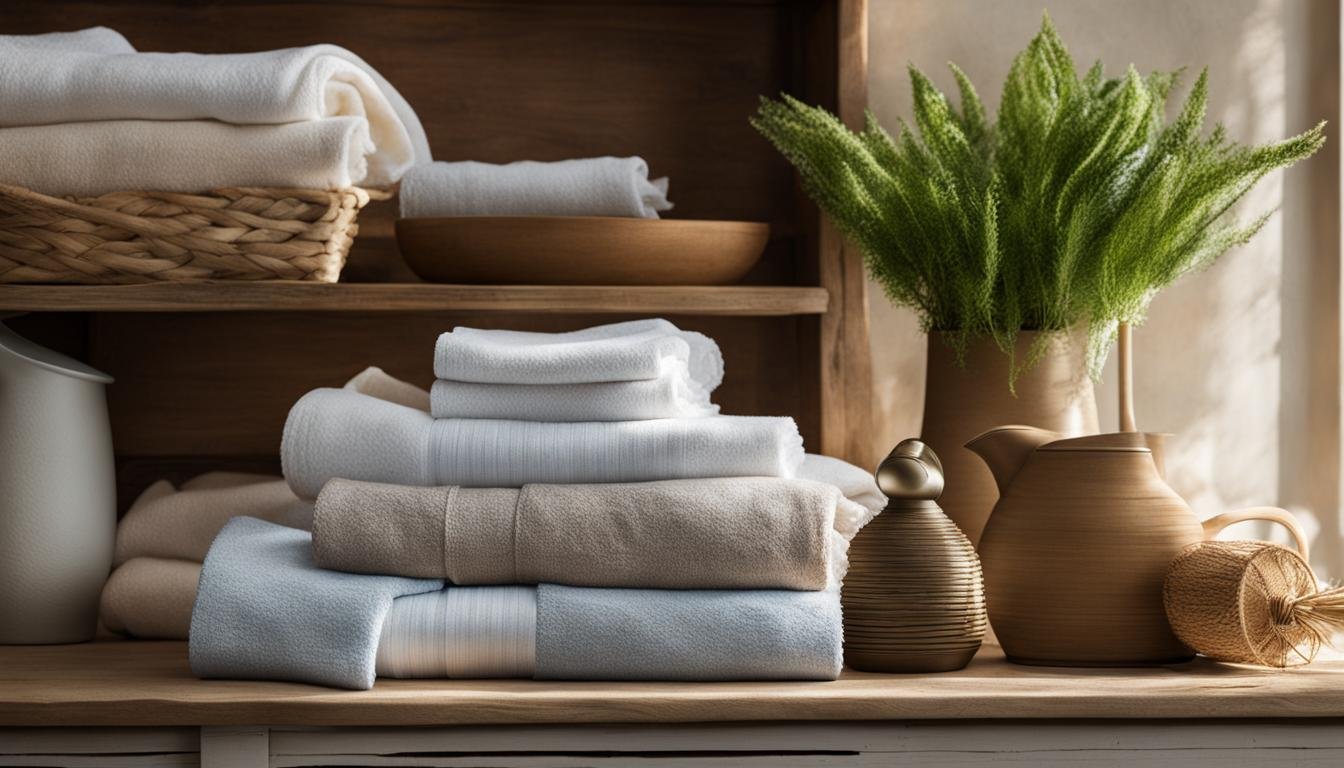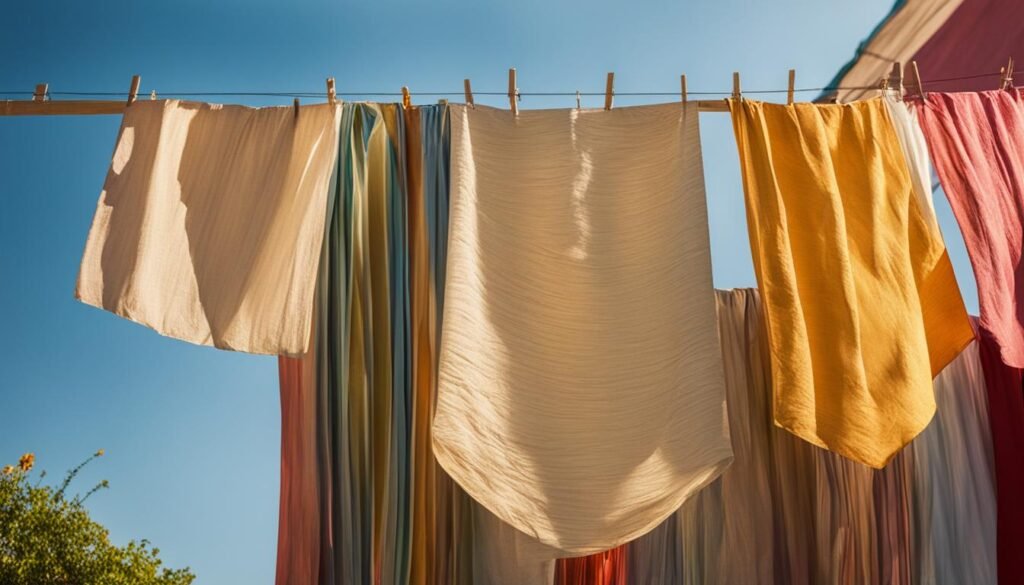Your cart is currently empty!

Washing and Drying Linen: Best Tips for Care
The key to maintaining the luxurious feel and longevity of linen items is rooted in mastering the basics of washing and drying linen. Reputed for its strength and breathability, linen stands as a testament to durable and sumptuous fabric, demanding simple yet intentional care to preserve its unique qualities. This guide will unravel the nuances of caring for linen—from selecting the apt water temperature to choosing the right laundry aids, ensuring your treasured pieces stay pristine wash after wash.
Demystifying laundry tips for this natural textile, we delve into the essentials of linen fabric care, including how to handle stains, which detergents are linen-friendly, and the proper drying techniques. Understanding these foundational points can significantly extend the life of your linen and keep it looking and feeling as good as new.
Key Takeaways
- Segregate linen based on color and wash separately to avoid damage and dye transfer.
- Use lukewarm water and mild detergents to prevent linen from shrinking and maintain fiber integrity.
- Avoid high heat drying; remove linen while slightly damp and allow air drying to finish.
- Immediate treatment of stains with gentle solutions can save linen garments from permanent blemishes.
- Regular care and avoidance of harsh chemicals like bleach are pivotal to preserving linen’s natural softness and color.
- Storing linen clothing in dry, well-ventilated spaces away from direct sunlight ensures longevity.
- Appreciate linen’s natural creases as part of its charm, and iron only when necessary, using a medium-hot iron on damp fabric.
Mastering Linen Laundry: The Essentials of Washing Linen
When it comes to linen care benefits, accurate washing and drying techniques are not just recommendations—they are essential practices to ensure the enduring beauty of this premium material. By exploring and adopting the best linen laundry techniques, you can revel in the lush comfort and aesthetic of well-maintained linen products.
The Benefits of Properly Laundering Linen
Washing linen appropriately enhances its natural advantages, including improved softness and sustained durability. This is one textile that rewards careful handling with increased comfort and an ageless appearance.
Hand-Washing vs. Machine-Washing Linen
Choosing between hand-washing linen and machine-washing linen depends largely on the item’s weave and soil level. Both methods are viable, but careful attention must be paid to ensure the longevity of your linen items.
Choosing the Right Water Temperature and Detergent
- Adhere to a linen wash temperature below 104°F (40°C) to prevent shrinkage.
- Opt for a mild detergent for linen, steering clear of harsh chemicals to maintain the fabric’s integrity.
Preventative Measures for Linen Care
Being proactive in linen maintenance includes avoiding overloading in machine washes and using the correct wash settings. Here are detailed recommendations:
| Linen Item | Washing Method | Water Temperature | Detergent Type | Special Notes |
|---|---|---|---|---|
| Bedding | Machine wash | Lukewarm ( | Mild | Turn inside out, fasten closures |
| Clothing | Hand/Machine wash | Lukewarm ( | Mild, no bleach | Wash separate from heavy textiles |
| Home Textiles | Machine wash | Lukewarm ( | Mild, avoid optical brighteners | Avoid heavy-duty cycles |
To truly harness the linen washing tips provided, incorporate these practices consistently into your routine. Doing so helps avoid common pitfalls like avoiding linen damage and promotes a preventative approach to linen care, guaranteeing your linen remains a bastion of comfort and resilience in your home.
Washing and Drying Linen: Methods for Maintaining Texture and Color
Essential to maintaining linen texture and ensuring color retention, the laundering process of this venerable fabric should be handled with precision and care. The unique weave of linen demands meticulous methods for drying linen and washing, guaranteeing its celebrated durability and aesthetic appeal is preserved through every cycle.

To begin, segregating your linens by color before washing is a cornerstone of textile care, crucial for preventing color bleed and encouraging color retention. Linen’s enduring texture also benefits from this practice, as it diminishes the risk of roughening caused by the friction between differing fabric types and hues. Linens with a ‘Dry Clean Only’ tag can often be carefully washed at home on a gentle cycle, though special attention should be paid here to protect the garment’s structure and detailing.
Drying linen techniques further influence the overall quality of your linen items. Where possible, air drying is the optimal choice, not only for energy conservation but also for enhancing the natural softness of the material. This method diminishes the harshness that can accompany machine drying, maintaining the lush handfeel linen is renowned for. Importantly, avoid drying linen in direct sunlight to protect the fabric from potential fading and weakened fibers. For items that must be machine dried, opt for a low heat setting and remove the linen while slightly damp to complete the drying process in open air, utilizing the inherent breathability of the fabric that promotes rapid evaporation.
Embrace the naturally occurring wrinkles as part of linen’s allure, understanding that while these creases are characteristic, they can be minimized through careful laundering. After washing, gently iron your linen on a medium heat setting while the fabric is still damp for a smooth finish. This acts not just as a cosmetic touch but also as a means to relax the fibers, smoothing out the surface and promoting a supple drape.
Attention to detail in laundering can significantly impact the lifespan and appearance of linen apparel. Maintaining linen texture and color retention requires more than just a cursory clean; it’s an art that, once perfected, allows the natural allure of the fabric to shine, wear after wear.
| Linen Type | Washing Recommendations | Drying Advice | Ironing Tips |
|---|---|---|---|
| Garments (General) | Gentle cycle or hand wash, separate by color | Air dry on flat surface or hang dry | Iron damp on medium heat without stretching |
| Detailed Apparel | Handle with care, ensuring extra space in wash | Hang immediately after washing to reduce creases | Use steam to gently ease out stubborn wrinkles |
| ‘Dry Clean Only’ Items | Gentle cycle, if permitted by label, with similar fabrics | Lie flat away from sunlight to preserve color | Iron inside-out to protect outer detailing |
Conclusion
As we have journeyed through the best practices for the care of linen, the path to a long-lasting and vibrant linen lifespan has been clearly laid out. It is through the adoption of correct washing techniques and the art of gentle drying that one can ensure the extended durability of their linen items. From bedding to clothing, these methods are not just beneficial; they serve as the crux of durable linen care. By adhering to the appropriate linen care guidelines, you’re not only preserving your fabrics but also investing in the timeless elegance that linen exudes.
Prolonging the Life of Your Linen with Correct Washing and Drying Techniques
Fortifying the lifespan of your linen relies heavily on correct washing techniques. Emphasizing lukewarm water, separation of colors, and the selection of mild detergents can thwart common damages ensuing from improper care practices. Moreover, when it comes to drying, shirking the urge to over-dry and implementing air-drying measures grant your linen items the breathability they require. This fosters an easy care linen routine, securing not only the longevity but also the structural integrity and aesthetic vibrancy integral to the fabric.
Embracing the Natural Qualities of Linen Through Proper Care
Beyond the practicality of its care, embracing linen for its inherent natural qualities is just as pivotal. Linen’s eco-friendly nature, coupled with its inherent breathability and strength, becomes more pronounced with each careful wash. As the fabric softens naturally over time, its ease of maintenance and quick-drying features establish it as an exceedingly advantageous textile choice. Acceptance of its natural creasing further magnifies the beauty and organic elegance of linen, which aligns seamlessly with a lived-in aesthetic. It is in celebrating these natural linen qualities that one finds a fabric not only easy to care for but also seamlessly integrated into a sustainable and stylish lifestyle.
FAQ
How should I prepare linen items before washing?
Before washing linen, it’s recommended to turn the items inside out, button up all buttons, close zippers, and check for any stains that may require pre-treatment. Ensure the linen has enough space to move freely in the wash to avoid damage.
Can I wash linen with other fabrics?
It’s best to wash linen with like fabrics and avoid heavy items like towels or jeans. Washing similar colors together also prevents color bleeding and maintains the integrity of your linen items.
What water temperature is suitable for washing linen?
The ideal water temperature for washing linen is up to 104°F (40°C). Exceeding this temperature can cause the linen to shrink. Always refer to the garment’s care label for specific instructions.
Should I use fabric softener when washing linen?
Fabric softeners are not recommended for linen as they can coat and weaken the fibers. Linen naturally becomes softer with each wash without the need for such products.
What is the best detergent to use for washing linen?
Use a mild detergent that is formulated for delicate fabrics to preserve the color and texture of the linen. Avoid detergents with bleach or optical brighteners.
How do I treat stains on linen fabric?
Treat stains promptly by dabbing the area with gentle solutions such as club soda or a mixture of baking soda and vinegar. Avoid rubbing the stain to prevent it from penetrating deeper into the fibers.
Can I machine dry linen?
Yes, linen can be machine dried on a low heat setting. However, to prevent stiffness, remove linen from the dryer while it is still slightly damp and hang or lay flat to complete the drying process.
How do I iron linen garments?
Iron linen fabrics while they are still slightly damp using a medium-hot setting. If the linen has dried, mist it with water before ironing to ease out creases. Ironing inside out can help protect the fabric’s surface.
Is air drying better than machine drying for linen?
Air drying is preferable as it is gentle on the fabric, saves energy, and can increase the fabric’s softness. Lay flat or hang to dry in a well-ventilated area.
How should I store my linen clothes to prevent damage?
Store linen in a cool, dry, and well-ventilated area. Avoid plastic bags and instead use natural materials like cotton bags to allow the linen to breathe and prevent mildew growth.
Is it necessary to dry-clean linen?
Dry-cleaning is not always necessary for linen and may be reserved for structured or detailed items. Many linens are washable, but always check the care label for specific instructions.
How can I minimize wrinkles in linen clothes?
To minimize wrinkles, remove linen from the washer or dryer while slightly damp and lay flat or hang it to dry. Gentle ironing on a slightly damp fabric can also help smooth out creases.
What should I do if my linen garment says ‘Dry Clean Only’?
If the label says ‘Dry Clean Only’, it’s best to follow the manufacturer’s recommendation. However, some ‘Dry Clean Only’ items can be gently hand-washed or machine washed on a delicate cycle, but proceed with caution and at your own risk.
Leave a Reply